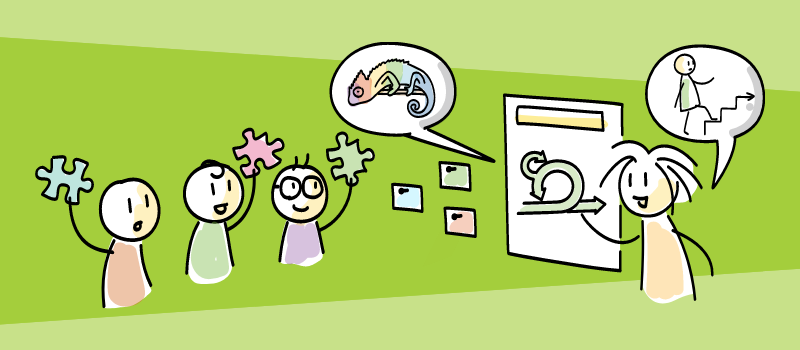Agile leadership styles
Agile leadership is, at its core, the ability to master multiple leadership styles to be able to adopt the one that fits the specific context and the team’s expectations. Because of the dependence on context, expectations and relationships, there are no leadership behaviors that are inherently positive or negative. It is more helpful to describe leadership behaviors as either more or less helpful within a specific situation. The way the leadership behavior is perceived by those affected is important in a given cultural context.
Being an agile leader does not mean using a coaching leadership style in every circumstance since this can be unhelpful, (or even harmful) in certain situations. An example is a crisis situation, or working with a team of people that expect clear directives. In both of these examples, a leader using a directive or demanding style can be a gold example of servant leadership. This is because they are intentionally adopting that behavior in a specific moment in the service of empowering them to be better and more autonomous.

Photo by Jason Goodman on Unsplash
How do you know which leadership style is most appropriate?
When you think of switching between leadership styles, it may seem like a tough challenge and even a little overwhelming at first. Agile leaders use emotional intelligence and are conscious of their own and other people’s emotions and perspectives. This helps them to adopt the appropriate leadership behavior in different circumstances. They are able to gently and iteratively shift their primary leadership style from directing towards coaching and catalyzing, in order to build agility and autonomy in their team and organization. This is a skill, and like any skill, it can be learned, practiced, and mastered.
Recommended for you: Master various Agile leadership styles in our online course on Agile Leadership Foundations
Six leadership styles to master
We can define six different styles (or behaviors) that can be developed and applied in different contexts and cultures.
Directing
The leader acts, and is perceived as, an expert and an authority. It is considered one of the more traditional leadership styles.They are therefore in charge of assigning and controlling work while being held accountable for the results of the group’s work. Discussion or negotiation is not usually welcome when leading in this way. Instead, the leader expects compliance from their followers.
When it works: This style is essential in a crisis or when people expect clear direction
When it doesn’t: In the wrong context, for instance, when people expect a certain degree of autonomy, a directing style can be stifling and cause frustration.
What holds the group together: The direct relationship with the leader, as well as a shared awareness of the possible consequences of failure
Demanding
The leader is perceived and acts as someone with extremely high standards. They are competitive and focus primarily on performance, leading by example. The followers focus on their targets.
When it works: When followers perceive the work as focused on results, a constant push from the leader can be motivating in the short term.
When it doesn’t: When used long-term, this style can cause a high level of stress.
What holds the group together: Meeting targets successfully as well as the leader’s conflict-solving skills.
Conducting
The leader coordinates and encourages collaboration, believing that collaboration is essential and increases quality. While the leader is responsible for enabling the collaboration, the followers feel responsible for their individual contribution. They can rely on help from their peers.
When it works: When followers know that they need to deliver the work, but expect the leader to retain the overall responsibility for delivering value, conducting can be effective.
When it doesn’t: This style can cause problems when people do not feel comfortable to organize their own work, or when they are not skillful enough to handle disagreements that emerge from cooperation.
What holds the group together: Clear roles and group dynamics
Envisioning
The leader motivates people by providing a compelling and challenging vision of the future. They inspire collaboration and a sense of shared responsibility. They have faith in their followers’ abilities. The followers value collaboration and they are motivated by their feeling of being able to learn and achieve more together.
When it works: This style is great for when the team believes that quality work can be achieved only through collaboration and collective agreement.
When it doesn’t: If the team does not have sufficient skills in collaborative decision making, this can cause difficulties.
What holds the group together: A team identity and a shared purpose
Coaching
This is the approach most commonly associated with agile leadership styles, however it is not always appropriate. The coaching leader supports team members with their personal growth and supports the team to become more effective as a whole by being a servant leader. The team shares responsibility and collaborates to achieve their goals. They are motivated by mastering challenges and learning continuously.
When it works: When the followers perceive the work as being self-directed and expect a high level of autonomy in achieving their goals.
When it doesn’t: When the followers do not feel comfortable with autonomy or do not have appropriate skills in giving/receiving constructive peer-to-peer feedback.
What holds the group together: A sense of belonging as well as the challenge of reaching their full potential.
Catalyzing
The leader amplifies the success of the team, connects them with the rest of the organization and ensures their contribution to strategy creation. The leader provides both praise and challenges and enables synergies. The followers are self-governing, maximize value delivery and incorporate customer feedback autonomously. They are open-minded, curious and adaptive. They are motivated by their contribution.

Photo by Terry Vlisidis on Unsplash
When it works: When the followers perceive their work as fully self-managed in terms of both the goal and how to achieve it.
When it doesn’t: When people are only focused on their own personal or team success and are unable to see the benefits to collaborate with the larger organization.
What holds the group together: A constant search for new challenges.
Want to learn more about Agile leadership styles?
Companies are investing more than ever in leadership development, and highly trained, skilled leaders are indispensable to the modern workforce. agile42 offers a number of training, coaching, mentoring and other services. You could start with the Golden Standard for Agile leaders, namely Certified Agile Leadership Essentials for Team and Organization Leaders (CAL-E+T+O) training, which we do in-person and remotely, or contact us for information about our other services. We also offer an online leadership course which will help you explore the various Agile leadership styles in more details.














 was used to the switch of context and the environment around us. We also learnt to adapt our behaviour and attitude accordingly depending on the specific client or employee. This is something that is very difficult to do when working remotely as we physically stay in the same place; we are likely dressed in the same way; we are looking at the same screen all day. So switching context when working remotely creates a significant amount of stress as we tend to think a lot more consciously rather than subconsciously about how we should behave.
was used to the switch of context and the environment around us. We also learnt to adapt our behaviour and attitude accordingly depending on the specific client or employee. This is something that is very difficult to do when working remotely as we physically stay in the same place; we are likely dressed in the same way; we are looking at the same screen all day. So switching context when working remotely creates a significant amount of stress as we tend to think a lot more consciously rather than subconsciously about how we should behave. In order to help people cope better with the situation and for you as leaders to understand how everyone is doing, you should consider having informal conversations. The informal conversations we used to have around the water cooler aren't as easy to have in a remote environment. As leaders we should consider having half an hour meetings with the team every week or every 2nd week to just talk about something other than work. Take your mobile phone and go for a walk outside - have a relaxing conversation. Check how people are doing; how their family is; what their interests are beyond work. Give them back that human touch we had in a physical environment.
In order to help people cope better with the situation and for you as leaders to understand how everyone is doing, you should consider having informal conversations. The informal conversations we used to have around the water cooler aren't as easy to have in a remote environment. As leaders we should consider having half an hour meetings with the team every week or every 2nd week to just talk about something other than work. Take your mobile phone and go for a walk outside - have a relaxing conversation. Check how people are doing; how their family is; what their interests are beyond work. Give them back that human touch we had in a physical environment. The first one is “isolation”. Now it might sound strange for me to even mention this, as it is obvious that while we’re all working more remotely and we’re not in the office seeing each other day-to-day we are bound to feel more isolated. I think it’s a really important thing to be aware of as we are missing out on a lot of things that we would consider to be our innate human needs.
The first one is “isolation”. Now it might sound strange for me to even mention this, as it is obvious that while we’re all working more remotely and we’re not in the office seeing each other day-to-day we are bound to feel more isolated. I think it’s a really important thing to be aware of as we are missing out on a lot of things that we would consider to be our innate human needs. 
 So as great leaders we can try to increase the opportunities for people to actually see each other, to get together, but not necessarily in a formal status sharing session. Perhaps informal coffee chats or building in time at the start of meetings to just talk about non-work stuff. Reinforce, re-establish that human connection again that will allow us to start thinking more positively of each other. As well as that, great leaders tend to role model this view of unconditional positive regard, choosing to believe that people are acting with positive intent. They take that action and they role model that to others to encourage others to choose to believe a positive interpretation of the possible interpretations.
So as great leaders we can try to increase the opportunities for people to actually see each other, to get together, but not necessarily in a formal status sharing session. Perhaps informal coffee chats or building in time at the start of meetings to just talk about non-work stuff. Reinforce, re-establish that human connection again that will allow us to start thinking more positively of each other. As well as that, great leaders tend to role model this view of unconditional positive regard, choosing to believe that people are acting with positive intent. They take that action and they role model that to others to encourage others to choose to believe a positive interpretation of the possible interpretations. 